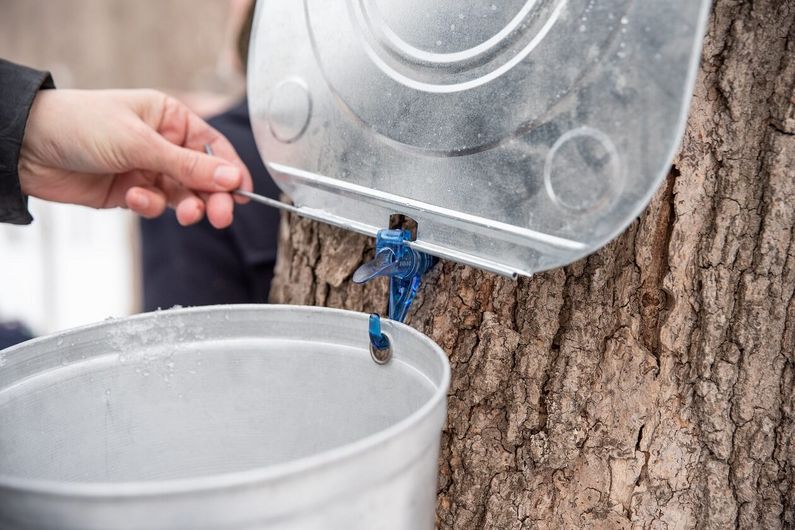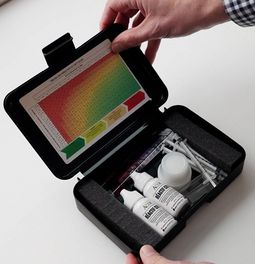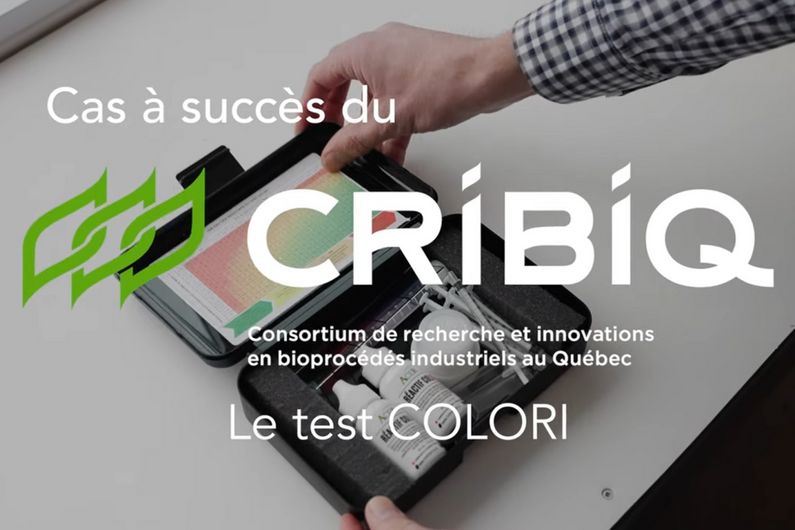Maple syrup season: chemists and mathematicians come to the sugar shack
- UdeMNouvelles
03/23/2023
Scientists at Université de Montréal join forces with Quebec's maple syrup producers to develop a rapid test that analyzes the quality of maple sap.
Quebec is a leader in maple syrup production and its “liquid gold” is world-renowned for its quality. To maintain this high standard, the Quebec Maple Syrup Producers association has partnered with scientists at Université de Montréal to develop a portable test to predict the quality of the syrup based on the harvested sap.
Dubbed the “COLORI test,” the method developed by UdeM’s chemists and mathematicians has been scientifically validated – the results were published Tuesday in the journal ACS Food Science & Technology – and last November was awarded the Prix Innovation 2022 | RSRI by the Association pour le développement de la recherche et de l’innovation du Québec.
“Thanks to the support of the Consortium for Research and Innovation in Industrial Bioprocesses in Quebec, we were able to develop the COLORI test, patent it and produce the first 250 units,” said Jean-François Masson, an UdeM chemistry professor and lead co-author of the scientific paper. “All the tests have already been used by the maple syrup producers who participated in our project.”
Fast and simple nanotechnology
The new COLORI test belongs to the nanotechnology family, and using it is quick and easy. It starts with a small tube containing a solution of gold nanoparticles, to which several drops of sap are added. The amino acids and the amines, which correlate with specific changes in the flavour of maple syrup, bind to the gold nanoparticles, causing them to group together and change the way light interacts with the solution. As a result, the solution changes colour from red to blue – a change that can be observed with the naked eye within minutes.
The main advantage of this test is that it can be used at the sugar shack, where the results can be immediately interpreted and acted upon. This highly sensitive and therefore highly effective method provides reliable information about the properties of maple sap in real-time to support the production of high-quality maple syrup.
“We encourage partnerships between companies and the public research community to create innovative solutions that meet specific needs and are commercially viable," said the Consortium's president and CEO, Mohammed Benyagoub. “The innovative COLORI project aligns with our mission to strengthen relationships and industry-university collaborative research by helping Quebec’s maple syrup industry ensure optimal purity of the syrup it brings to market.”
From detection to prediction
The COLORI test for identifying undesirable compounds in maple products is based on an earlier method developed in Masson’s lab in 2018 in collaboration with Simon Forest, then Masson’s research officer and now project manager for development and applied research at the producers' association. The first version of the test correlated the intensity of natural aromatic profiles of maple syrup (such as flavour profiles associated with sap and bud characteristics) to the result of the test.
“The COLORI test, which is now in its second version, has become predictive: it works with the maple sap and can determine if the compounds present in the sap harvested by the producer will yield high-quality maple syrup,” explained Forest, who also holds a master’s degree in chemistry from UdeM. “The test has proved useful as a decision-support tool: for example, to decide whether or not to boil sap that would not produce the desired quality of syrup.”
To move from the first-generation COLORI test to the predictive COLORI test, which provides information on the organoleptic profile of the sap, the two chemists asked QMSP to co-develop the new version of the test using a participatory science approach. This new COLORI test, which requires minimal infrastructure at the sugar shacks, was made possible by the involvement of several maple syrup producers, who participated in three phases of field tests.
Masson and Forest also called on the research team of Morgan Craig, an UdeM mathematics professor, to build a mathematical model that predicts the type of maple syrup that will be produced based on the molecular profile of the sap, including its amino acids. “Their model provides a sense of what the final product will be like, and allows maple syrup producers to better manage production,” Masson explained.
Soon to be widely available
Maple syrup production is one of the main drivers of Quebec’s biofood sector. The maple syrup industry contributed $1 billion to Quebec’s gross domestic product in 2022. With 13,300 maple syrup producers and total production of 95 million kilograms in 2022, the province is the world’s leading producer of maple syrup, accounting for nearly three quarters of global production.
To establish its market value, Quebec maple syrup is rigorously tasted, inspected, checked and classified according to criteria set out in the Convention de mise en marché du sirop d’érable, a marketing agreement developed by the QMSP. Large-scale deployment of the COLORI test would allow maple syrup producers to evaluate and classify maple sap at little cost before turning it into maple syrup, and would help them manage their production throughout the season.
“Quality is a top priority for Quebec’s maple syrup producers,” said Luc Goulet, president of the producers' association. “The COLORI test, which will be widely available as of 2024, offers our industry a unique tool to fine-tune our processes and maintain the reputation of Quebec maple syrup.”
For the current 2023 season, maple syrup producers can purchase a COLORI test kit by contacting the Centre de recherche, développement et de transfert technologique acéricole inc. (Centre ACER), in Saint-Norbert-d’Arthabaska. Supplies are limited.
About this study
"Prediction of maple syrup quality from maple sap with a plasmonic tongue and ordinal mixed-effects modelling" by Simon Forest et al. was published March 21, 2023 in ACS Food Science & Technology.
The study was funded by the Quebec Maple Syrup Producers, the Natural Sciences and Engineering Research Council of Canada and the Consortium for Research and Innovation in Industrial Bioprocesses in Quebec).
About Quebec Maple Syrup Producers
Quebec Maple Syrup Producers represents the interests of 13,300 maple producers and 8,000 maple enterprises. Quebec accounts for 72 per cent of global maple syrup production and exports to more than 70 countries. https://ppaq.ca/en/
About the Consortium for Research and Innovation in Industrial Bioprocesses in Quebec
The Consortium for Research and Innovation in Industrial Bioprocesses in Quebec is one of nine sector-based industrial research clusters created and financed by the Ministère de l’Économie, de l’Innovation et de l’Énergie du Québec. Its mission is to promote and support the realization of innovative industrial projects in the industrial sectors of the bioeconomy, based on the transformation and exploitation of agricultural, marine, forest and waste bioresources. http://www.cribiq.qc.ca/en/
About Université de Montréal
Deeply rooted in Montreal and dedicated to its international mission, Université de Montréal is a leading research university worldwide and among the five best French-language universities. With its affiliated schools, Polytechnique Montréal and HEC Montréal, UdeM attracts over $500 million in research funding every year, making it one of Canada’s top university research hubs. UdeM has close to 70,000 students, 2,300 professors and researchers, and an active global network of 450,000 alumni. umontreal.ca/en
Media contact
-
Jeff Heinrich
Université de Montréal
Tel: 514 343-7593















